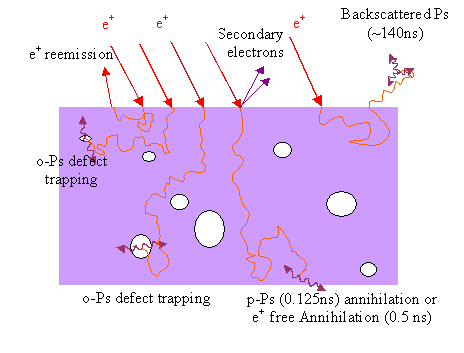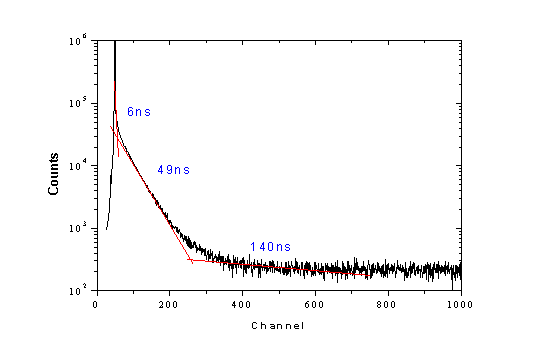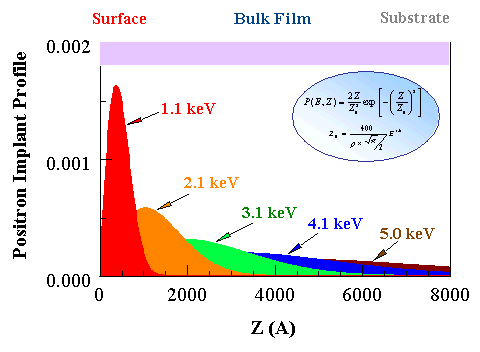|
Positronium Annihilation
Lifetime Spectroscopy
(PALS) Basics
PALS:
Measures positronium (Ps) annihilation lifetimes and
intensities, which can be related to the size and
amount of defect structures, such as voids
or pores in the range of several angstroms to tens of nanometers.
Suitable for insulating materials while
not good in the bulk of metals since Ps cannot be formed in the
latter. Beam-PALS:
A beam of monoenergetic
low-energy
positrons (several keVs) are used for thin film study. Thickness
of the film can vary from several nanometer to a few microns.
The energy of the implanted positrons are tunable, which enables PALS to
depth-profile thin films. For
comparison, positrons typically used for bulk
PALS have an implantation depth of 0.2 ~ 0.3 millimeters and as such are
unsuitable for probing thin films. Beam-PALS
technique is crucial to the success of this
research.
Positronium
(Ps): Neutral atom, bound state of a positron
(similar to electron in all aspects except positive charge) and an
electron.
Ps
interactions with condensed matter (Figure 1)
-
Reemitted
positrons
-
Positron
free annihilation: Lifetime less than 500 picosecond (10-12
sec)
-
Backscattered
Ps: formed by positrons diffuse back to the vacuum and capture an electron on the way.
Lifetime is ~ 142 nanosecond (10-9 sec, ns)
-
Secondary
electrons: positrons can knock off secondary electrons while entering
the solid material. (the signal is used as lifetime start signal in
PALS)
-
Singlet state (para-Ps
or p-Ps): lifetime ~ 125 psec,
-
Triplet state (ortho-Ps
or o-Ps) in vacuum: lifetime ~ 142 nsec,
-
Triplet state (ortho-Ps
or o-Ps) in condensed matter: prefers to stay in defects or pores.
Lifetime is reduced by
interaction with molecular electrons during collisions with the pore surface.
The collisionally reduced o-Ps lifetime is correlated with void size and
forms the physical basis for probing pore structure with PALS.

Figure
1
.
Positron and Ps interactions with condensed matter
Lifetime
measurement
-
Start
Signal: While being implanted into the film, positrons knock off
secondary electrons which starts the timing clock. (The time for positrons
to form Ps is on the order of picosecond, i.e., 10-12 sec,
which can be neglected compared to Ps lifetime on the order of
nanosecond.)
-
Stop
signal: Ps annihilates into gamma-rays, which stops the timing
clock,
Typical PALS spectrum
(histogram, Figure 2):
-
The prompt peak:
includes events such as para-Ps, free positron annihilation (each with
lifetime less than 0.5 ns). These
signals, which can account for 50 –90 % of the total events, unfortunately, do
not provide any information about the properties of the materials to be studied
-
Ortho-Ps
components: exponential decay, each
corresponding to a type of ortho-Ps behavior in open-volume in the solid. The lifetime relates to void or pore size while the intensity
relates to the amount of such defects.
-
Backscattered
Ps: Ortho-Ps in vacuum, with lifetime around 140 ns.
Everpresenting signal in beam-PALS in thin-film study. The intensity
is reversely proportional to the beam implantation energy.

Figure 2.
A typical PALS spectrum with three film Ps lifetimes fitted using POSFIT.
The points for each channel have been connected with a line for visual
clarity. Each channel
corresponds to 1.25 ns.
Depth-profiling
capability
The
major advantage of beam-PALS is the ability to control positron implantation by
varying the beam energy. The
implantation distribution for several beam energies is shown in Figure 3 for a
density of 1.0 g/cm3. Samples can be depth-profiled by varying the incident beam
energy and hence the mean implantation depth.
This is the critical feature that allows analysis of surfaces, thin films
and inhomogeneous films.

Figure
3. Positron implantation profile at different beam energies assuming a
film density of 1.0 g/cm3.
|